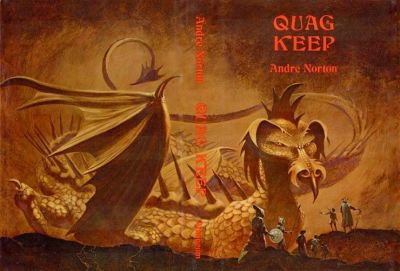Roll for Initiative
Quag Keep (Quag Keep, volume 1)
By Andre Norton

9 Jan, 2022
1978’s Quag Keep is the first volume in Andre Norton’s Quag Keep duology. Set in the world Gary Gygax’s Greyhawktmroleplaying game, it has the distinction of being the first Dungeons and Dragons novel.
Impressed by his gamemaster’s new miniatures, Miles touches one of the small gaming figurines. No sooner does he do this but he and his fellow roleplayers are transported to a tavern in the fantastical city of Greyhawktm.
Miles does not marvel at Greyhawk because he is immediately subsumed into the character Milo, with no conscious memory of Miles. One of Milo’s wrists bears an odd bracelet adorned with dice. Others have similar bracelets: Niale Fangtooth (wereboar Berserker), who has a pseudo-dragon familiar named Afreeta, Ingrge1 (elf archer), Yevele (battlemaid), Deav Dyne (cleric), Wymarc (Bard) and Gulth (lizardman). None of them can explain what the bracelets are or why the dice sometimes spin.
The wizard Hystapes helpfully intervenes to provide an explanation and a mission. Fictions on one world can have echoes in other realities. The D&D game provided an agent of chaos, a dimensional invader, with an opportunity. Drawing Miles and company across worlds is the first step between merging worlds. This would be Bad, for reasons that are unclear.
While Milo and other players cannot escape the spell of which they are a part, they may be able to prevent the game’s ultimate goal from coming to fruition. However, to do that, they need information Hystapes cannot provide. Perhaps the dragon Lichis can provide the necessary information.
If the party can find their way to the dragon despite the dangers of the countryside and the efforts of enemy agents. If the dragon will speak to puny humans, elves, and lizardmen rather than simply eating them. If that works, then the group will face the greatest challenge of all: defeating the evil gamemaster.
~oOo~
I worked for a company that made war gaming and roleplaying miniatures. None of them ever transported entire groups of people to other worlds. This may be because to save costs, the company used an amalgam of lead and bismuth, rather than the more common (and more expensive) lead-tin.
This book appeared very early in the history of tabletop roleplaying. D&D was only four years old when this novel was published. Official sources on Greyhawktm (the setting for Gygax’s own campaign) were slender.
Readers familiar with the early 1980s boxed set

should be aware that Norton’s version differs in important details from the official version2 that eventually emerged.
Readers might expect that this was published by TSR. Not so. Quag Keep was published by Margaret K. McElderry Books and DAW Books. TSR would not, as far as I can tell, publish its own novels until 1982 and even then, they never published an edition of Quag Keep (which was out of print in English from 1987 to 2006).
Andre Norton was cited (in the first edition AD&D Dungeon Master's Guide) as an author who had influenced Gygax. Perhaps this is why Gygax picked Norton to write the first Dungeons and Dragons novel. The novel’s acknowledgement does not cast much light on the process leading up to the publication of the novel:
The author wishes to express appreciation for the invaluable aid of E. Gary Gygax of TSR, expert player and creator of the war game, DUNGEONS AND DRAGONS, on which the background of QUAG KEEP is based. I wish also to acknowledge the kind assistance of Donald Wollheim, an authority and collector of military miniatures, whose special interest was so valuable for my research.
Note that she calls it a war game. D&D grew out of miniature wargaming. Gygax’s approach to Dungeon Mastering was adversarial. Perhaps this is why the Big Bad in this book appears to be a rogue DM. Or perhaps inter-universal machinations of PURE EVIL had fallen out of vogue by the time I encountered roleplaying games.
Still, 1978 is pretty much as early as a D&D tie-in novel could have appeared and Quag Keep is generally acknowledged as such. It’s a bit of a shame, therefore, that it’s not a particularly good novel, not even as good as one of the minor Witch World books. The plot is much like a D&D adventure run by a lousy, hostile DM. Nothing really makes much sense but the “collect the tokens” plot (which could also be described as a “visit the locations” plot). Frequent random monster encounters move things along until the finale. Characters are two-dimensional. Their motivation? Characters have no choice but to participate. In short, Quag Keep is the harbinger of mediocre-to-terrible D&D tie-in novels to come, of which TSR published quite a few before imploding into bankruptcy in the mid-1990s. There is a reason Quag Keep was out of print for nineteen years.
Quag Keep is available3 here (Amazon US), here (Amazon Canada) and here (Amazon UK).
I did not find it at Barnes & Noble, Book Depository, or Chapters-Indigo.
1: We don’t need no stinking vowels.
2: One bit that caught my eye: the primary conflict being law versus chaos (good vs evil was a later addition), all creatures of law have an inherent ability to sense chaos. This must make subterfuge challenging.
3: Readers may note that the SFBC published a 2-in-1 of Quag Keepand the 2006 sequel, Return to Quag Keep (which is equally bad, just in a different way). I wrote the report for that!
